The Study-Abroad Programs
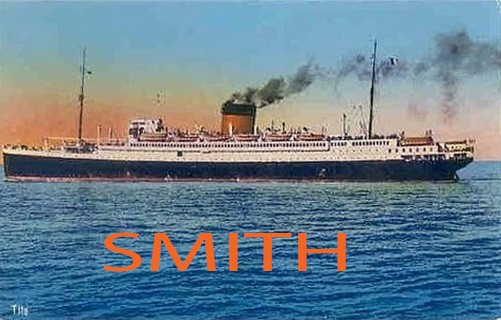
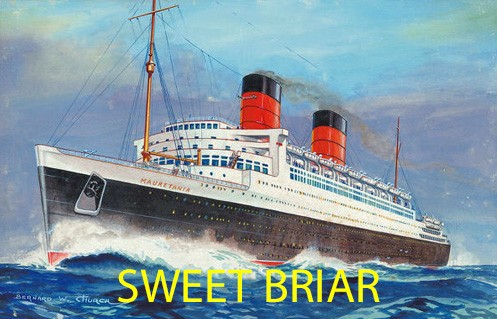
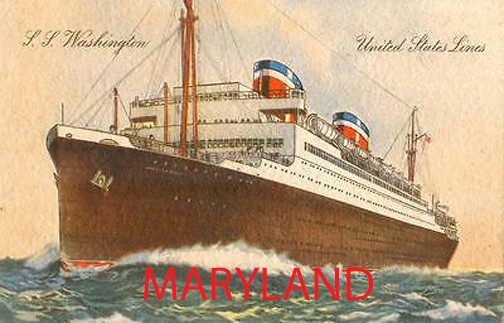
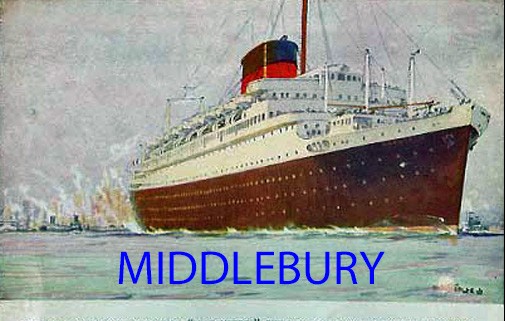
In the early years, the majority of residents at Reid Hall were research fellows or independent students enrolled at the Sorbonne or other centers of higher education in Paris. With the emergence of study-abroad programs in the U.S., several formal undergraduate and graduate study programs sent cohorts of students to Paris for year-long or short-term summer opportunities. As a reputable French-American institution, Reid Hall became a logical setting for several of these programs. Their students and directors either resided at Reid Hall or used the property for seminars and meetings. In an effort to attract residents, Reid Hall granted scholarships to students and faculty. Three or four summer meal scholarships were also given to French women, ensuring that French would be spoken at mealtimes in the Reid Hall dining room.
Smith College, which already had a long experience with sending students to France and whose President was in regular contact with Gildersleeve, was the first to inaugurate the opening of Reid Hall, sending 35 students in 1947. Reid Hall provided a comfortable refuge from post-war circumstances. The University of Delaware, which had maintained offices at Reid Hall from 1934 – 1936, asked to return in the late summer/early fall of 1947. In 1948 and 1949, Sweet Briar College sent 75 students to Paris, many of whom stayed at Reid Hall. Middlebury College created a graduate study group in 1948 and used Reid Hall as its headquarters. Also in 1948, the University of Maryland graduate study program, comprised of 20 men and women, met at Reid Hall for their seminars but resided elsewhere in Paris. Hamilton College began its own study-abroad program in 1957, using Reid Hall as its headquarters and teaching facility.
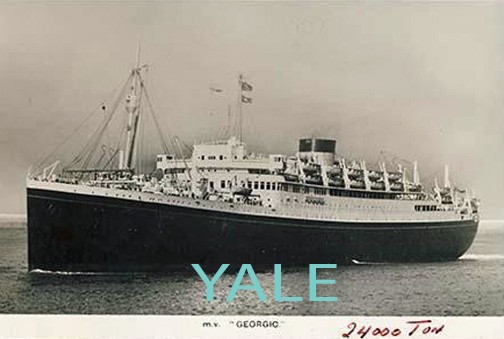
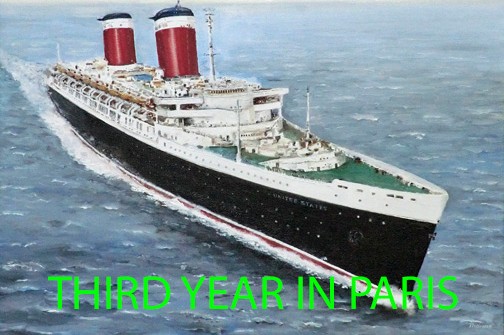
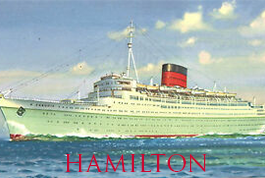
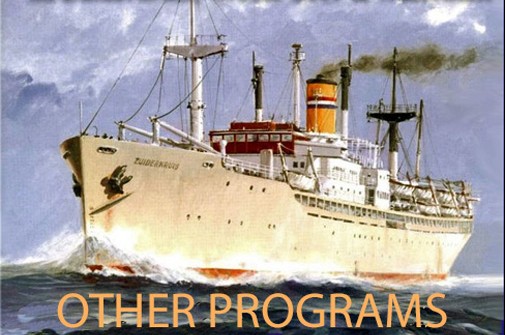
With the continued growth of study abroad-programs at American universities, Reid Hall began to welcome more and more student residents and study groups; during the academic year or in the summer, it was also used for orientation sessions and courses. For all students, it served as a hub for information on cultural activities, site-visits, excursions, and practical documentation. Students were also encouraged to attend the various events that took place at Reid Hall: teas, lectures, diners, conferences, receptions, and other gatherings.
Dorothy Leet developed Reid Hall's own academic offerings, beginning with the Yale-Reid Hall Summer program that ran from 1950 to 1960, followed in 1951 by the highly successful Third Year in Paris, which ended when the property was turned over to Columbia University.
As the 1950s progressed, many of these programs relocated some or all of their students to Parisian host families, preferring immersion in French daily life to an American dorm-like atmosphere. They nevertheless continued to use offices at Reid Hall as their administrative headquarters, benefiting from its library and common spaces, and taking advantage of classrooms and conference rooms for courses, lectures, and meetings..
While some study programs closed their operations or moved to other parts of France, Smith, Hamilton, and Middlebury pursued their operations well into the 20th century, joined by other study programs for whom Reid Hall became an academic home away from home.
Smith
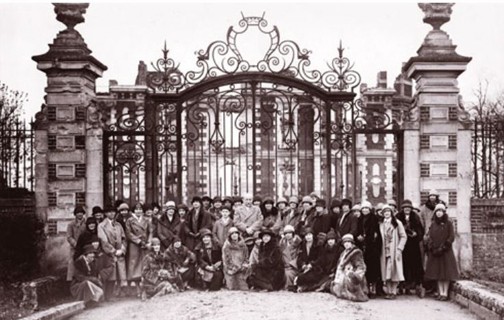
President William Allan Neilson, center, posed with the class of 1927 Juniors in Paris using the gates before the Chateau of Robecourt in Grécourt, France, as a backdrop. A reproduction of these gates had been cast in France and was erected at the entrance to Smith College in 1924 in recognition of the service of the Smith College Relief Unit in France from 1917 to 1920. Photograph by Wide World Photos, Smith College Archives.
William Allan Neilson, Smith College's third President from 1917 – 1939, was a firm believer in international cooperation as a means of achieving world peace. During those early tumultuous decades of the 20th century, he established Smith's Junior Year in Paris. In 1919, he had supported the Smith Relief Unit in their efforts and instituted a "Committee on the Exchange of Students with Foreign Countries" to oversee the fellowships extended by the French government to Smith students at the École normale supérieure de Sèvres (Gantrel 8). In 1935, he was decorated with the French Legion of Honor in recognition of his work on student exchange programs.
In my opinion, the Junior Year Abroad is [...] the most valuable year spent in college. The students not only get a mastery of a foreign language and the contents of the usual number of courses but acquire a higher degree of maturity and breadth of view. It is an important means of creating understanding of people of another country and so it is part of our campaign for better international relations (Neilson, 1934).
Correspondence preserved in the Smith College Archives between President Neilson and Director of the Reid Hall Board, Barnard's Dean Gildersleeve, demonstrates the close relationship between the two educators and their shared vision for the international education of women. It is therefore not surprising that Reid Hall became the focal point of Smith's study abroad initiatives.
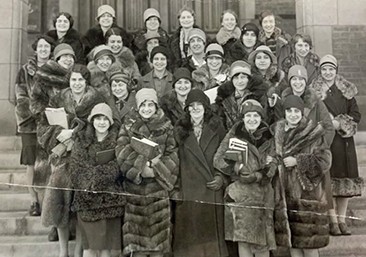
An early group of Smith juniors in Paris, ca. 1920s. Photograph retrieved from the Smith College Archives
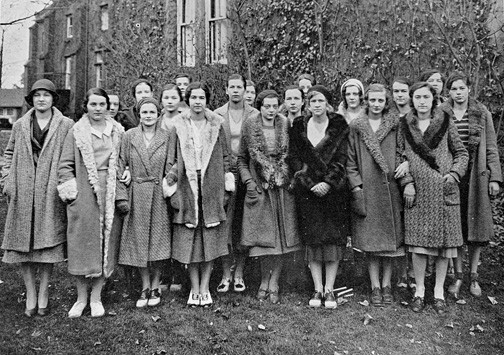
Group of Smith students, 1931. Photograph retrieved from the Smith Archives.
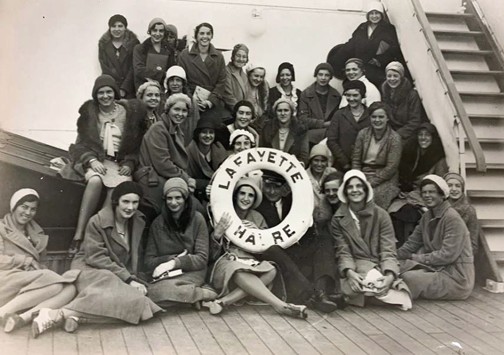
Smith's class of 1932 JYA participants, en route to France in 1931, Smith College Archives
The Committee's work expanded as President Neilson and Professor Hélène Cattanès of Smith's French department formulated a proposal for the program that would become Smith's Junior Year Abroad (JYA) in Paris. Despite concerns from the faculty about the safety of the "girls" in a foreign country, and about the sustainability of such an endeavor, the "Paris Plan of Study" passed a faculty vote in January 1925 and the first group of 32 Smith students, all French majors, boarded a transatlantic liner bound for Le Havre in August of that year. Prof. Cattanès traveled with the students and served as the program's first director. Though the JYA students did not live at Reid Hall as part of their year abroad, they were frequent guests at the University Women's Club and were cherished members of the community.
One major reason that Smith students were not domiciled at Reid Hall was the program's support of the construction of an American dormitory at the University of Paris's Cité Universitaire, to be housed between the English and Belgian dorms in a sort of "educational village." Personal preference also factored into the students' decisions to live with French families and not at Reid Hall. A memo from Smith's Professor Byam dated February 6, 1935 notes that Smith students did not live at Reid Hall because "not a single student was satisfied with the rooms at that place, the chief reason being that the building is too similar to an American dormitory" (Junior Year Abroad-France, Smith JYA Records, B50F6, folder 32, Smith College Archives).
Like all other American study-abroad programs, JYA in Paris was forced to shut down during WWII. Upon the resumption of "normal" activities across Europe, the JYA program was revived in 1946, constituting the first group of American students on European soil since the end of the war. They studied in Geneva as the socioeconomic situation in postwar-France was still quite uncertain.
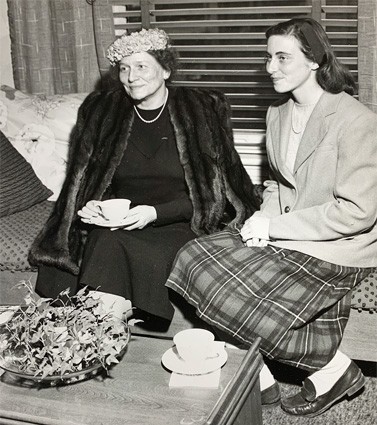
Dorothy F. Leet and student Lucy Elmer, 1948 at Smith College. Smith Archives
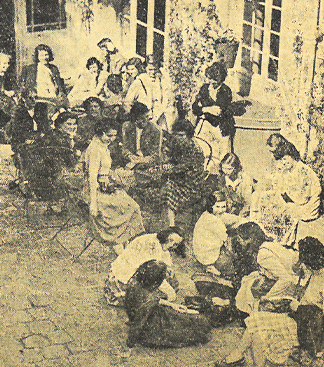
Group of Smith students in Reid Hall's first courtyard, 1948. Photograph retrieved from the New York Herald Tribune, Paris, September 28, 1948, n.p. Retrieved from RH archives, scrapbook.
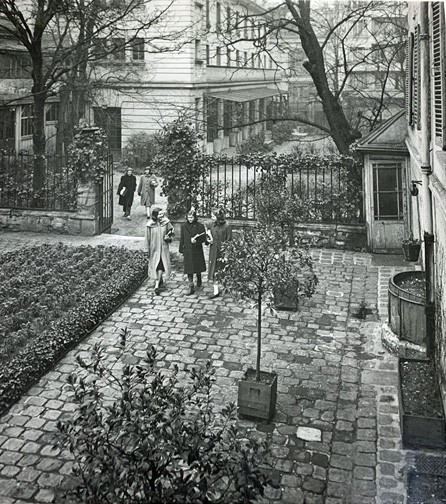
Smith students in Reid Hall's courtyard, 1949. Smith Archives
In 1947, a group of 35 young women sailed to Le Havre via the SS De Grasse, which would serve as the favored Smith ocean liner for years to come. Since Parisian families were still struggling with food shortages, Reid Hall became the best alternative to full immersion. The JYA students, who averaged 20 years of age, represented different women's colleges on the East Coast: Smith, Bryn Mawr, Russell Sage, New Jersey College of Women, Barnard, Wilson, etc. (The Herald Tribune, November 29, 1947). Most students were French majors, with some majoring in music, history, or art history. They studied mainly at the Sorbonne, the Institut d’études politiques, and the Louvre. Madeleine Guilloton, who had headed the Smith program in the 1930s, accompanied the group to Paris and directed their academic and social life, ensuring that students upheld the French-speaking pledge at all times.
Dorothy Leet visited Smith College in April 1948 (New York Sun, April 21) to talk about France, Reid Hall, and meet potential candidates for the JYA program. Her presence generated great enthusiasm on Smith's campus, and the program firmly established its headquarters at Reid Hall.
In the 1948 – 1949 and 1949 – 1950 academic years, there were 38 and 35 students respectively, with approximately 25 living at Reid Hall, under the supervision of Marthe Sturm, translator and Associate Professor of French at Smith. An increased number of classes taught by French university professors were held on-site:
The Smith College Group follows its autumn courses at Grenoble but is holding at Reid Hall an increasing number of winter and spring courses, given by distinguished university professors. This is due to the fact that Junior Year students are not qualified to follow regular classes for French students at the Sorbonne and must, therefore, enter only classes arranged for foreigners in the "Cours de Civilisation Française," which are below the academic standards of the Juniors, and which are crowded with Americans who are not obliged to fulfill any academic requirements for entrance to these courses (RH Report, 1949-1950, Barnard Archives).
In 1949 – 1950, the program adopted a new residency pattern: for the first six weeks, students lived with families in Grenoble. They then went to Paris, where the group was split in two, with one cohort living at Reid Hall in the fall and the other in Parisian households. The two groups swapped residences in the Spring semester.
At Reid Hall or with French families, students followed a strict code of conduct. Below is an excerpt from the “Règlement à l’usage des Familles et des Étudiantes” that applied to the academic year 1959 – 1960:
- Students have an 11pm curfew, but they are permitted to stay out until 1am three nights per week.
- Any outing past 1am can only be accepted by the host if the student presents written authorization from the the program director.
- Hitch-hiking is forbidden.
- Riding a Vespa is forbidden.
- Water and electricity are very expensive in France and students must avoid all waste (i.e. leaving a room without turning off the lights or turning on the lights without reason). Two baths a week are allowed; students will be billed for additional baths.
- Men are not allowed to visit bedrooms. Host families can offer a salon or common room for socializing.
- No alcohol is permitted in bedrooms.
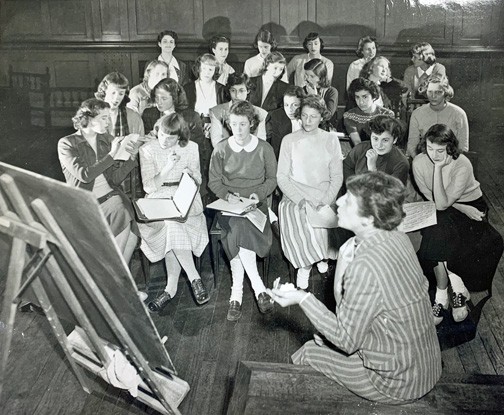
Smith students in Reid Hall's Grande Salle, 1952. Photograph retrieved from the Smith Archives.
In 1950 – 1951, 34 juniors participated in the program, which was directed by Jeanne Saleil, Smith professor of French who, during the war years, had headed the French house (Dawes House) on Smith’s campus. She led the JYA program through 1961 and other professors from Smith, like Guilloton, taught French grammar, phonetics, etc. The program averaged some 30 students each year. By 1960, the president of Smith College remarked that their program was "so popular we have to turn down one out of every three applicants" (Toy 1960).
As time passed, the Smith students increasingly chose to live with French families, using Reid Hall for classrooms, receptions, and as their administrative hub. Correspondence in the Smith Special Collections document students’ attachment to their French host families, with whom they formed bonds that went beyond their year in France.
Even after Columbia had taken over the property, Smith's JYA program was calling Reid Hall home in every sense of the word. In the 1960s, three Smith professors were particularly active in developing the program and overseeing its academic and cultural objectives:
- Josephine Ott: After working as assistant director of the Sweet Briar College program in 1956 – 1957, she began leading the Smith program in 1961. Throughout her career at Smith, she was dedicated to the Paris program and served as its director on seven separate occasions.
- Patricia Weed: herself a graduate of the program, was also a frequent and enthusiastic Director of the Junior Year in France.
- Marie José Delage:
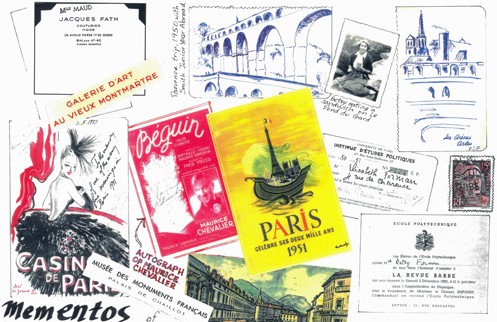
Mementos from the JYA 1950 – 1951 group. Grossman. Smith Archives
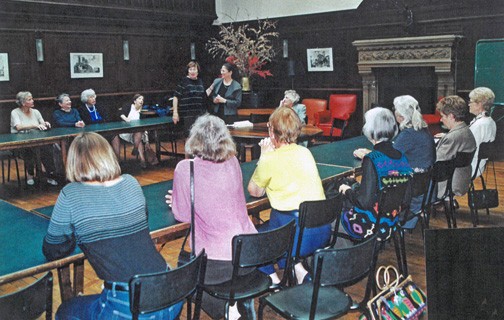
Smith JYA 1950 – 1951, Reunion in 2000, Grande Salle. Grossman. Smith Archives
Numerous Smith alumnae have returned to Reid Hall since their formative year in France, which remained indelible in their mind, and, for many, French became a second language. Alumnae came together at Reid Hall to celebrate the program’s fiftieth year. One alumna edited a scrapbook, which is housed in Smith's archives, based on the photos and mementos of the time they spent in France. In 2015 – 2016, yet another group celebrated the program’s ninetieth year. Several of the women had remained in France, married French men and established careers in Paris. Others had returned to the U.S. but regularly visited France or invited members of their French host families to America.
Reid Hall is still the program's academic home and headquarters. In fact, it occupies the same space secured by Smith so many years ago. In 2020, the program's emphasis remains immersion in French society, language, and culture:
It is a year‐long program; students start the year with an orientation during which they take classes in French language and methodology, and learn about the history and culture of France; they live with families and study at French universities; and they are under the supervision of a faculty member who belongs to their home institution and serves as their academic adviser (Gantrel 11).
Sources
- Association des Former Juniors in France of Smith College, eds. Mémento de l’année en France.
- Bulletin of Smith College, 1939 – 1940. Forgotten books.
- Byam, Edwin C. and Marine Leland. “American Undergraduates in France.” The French Review, vol. 3, no. 4, February 1930, pp. 261-269. JSTOR.
- Cattanès, Hélène. “Vers d’autres horizons.” Mémentos de l’année en France, 1965.
- Gantrel, Martine. "The First Junior Year Abroad Programs in France (1923-1939): How They Started and Why?" Retrieved from Academia.
- Garlitz, Richard and Lisa Jarvinen. Teaching America to the World and the World to America. Springer, 2012, pp. 249.
- Grossman, Joan Pines Abeshouse, ed. Les petites Smiths 1950/2000: A Scrapbook. Smith Archives.
- Guilloton, Vincent and A. M. Palmer. “American Students of French in France.” The French Review, vol. 2, no. 3, January 1929, pp. 241-246. JSTOR.
- “Junior Year Abroad.” Brochure, 1988 – 1989. Smith archives.
- “Junior Year Expanded.” Alumnae Quarterly, 1947. Smith archives.
- Leet, Dorothy F. Annual Reports, 1948 – 1954. Barnard archives.
- Leet, Dorothy, F. Letter to Members, 1951 – 1964. Barnard archives.
- Perlman, Anne. “American College Girls Gain Insight on French Life Along the Seine.” Paris Herald Tribune, November 29, 1947. n.p. Retrieved from RH archives, scrapbook.
- Mah, Ann. "A Year in Paris That Transformed Jacqueline Kennedy Onassis." The New York Times, June 30, 2019. nytimes.com/2019/06/23/travel/paris-jacqueline-bouvier-kennedy-onassis-college.html
- “Smith College Group Comes to Paris.” New York Herald Tribune, Paris, September 28, 1948, n.p. Retrieved from RH archives, scrapbook.
- “They’re Going to Paris. New York Sun, April 21, 1948, n.p. Retrieved from RH archives, scrapbook.
- Toy, Steward. "Exporting Students: U.S. Colleges Expand Programs for Study in Foreign Countries." Wall Street Journal, December 9, 1960, p. 1. ProQuest Historical Newspapers.
- Vickery, Margaret Birney and Nina Antonetti. Smith College, Princeton Architectural Press, 2007. pp. 162.
Sweet Briar
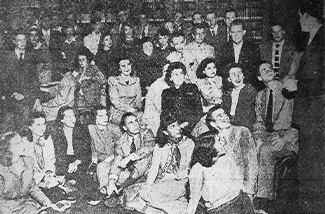
Students briefed by Theodore Anderssen, Director of Sweet Briar's JYF. New York Herald Tribune, September 8, 1948, n.p. Photograph retrieved from the RH archives, scrapbook.
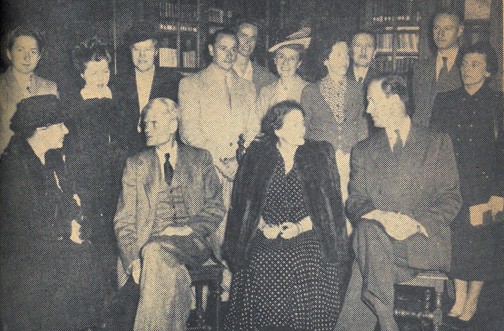
Sweet Briar College, Joseph E. Barker (Chair Romance Languages), Dorothy Leet, and Theodore Andersson. Photograph retrieved from SB News, 1948, p. 3.
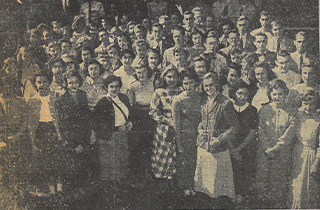
Sweet Briar Study Group, 1949 – 1950, 53 women, 20 men. Photograph retrieved from Herald
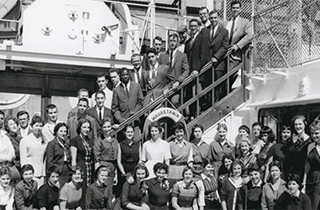
Sweet Briar students on the Mauretania, 1957-1958
Since 1948, over 7,200 students representing more than 280 colleges and universities have been enrolled in the JYF program (Sweet Briar Alumni Magazine, 2016).
The Institute of International Education authorized Sweet Briar College to take over the University of Delaware Foreign Study Plan, which had begun in 1923. Born out of an American soldier's experience in France (New York Herald Tribune, Jan 18, 1948), this initial Delaware group had 8 students, and, by 1933, it had 90. Like Smith College, the program ceased all activities during WWII, but resumed in Geneva in 1946. Leet had written to George Brinton of the Delaware group to see if they might return to France; he told her that they had opted for Geneva as a safe site for their students, and that he would not be able to send students to France until March 1947 (Brinton, March 14, 1946). Delaware remained in Geneva through 1948.
Due to a lack of funding, the program was shut down in 1948. Joseph Barker, a professor at Sweet Briar who had headed the Delaware Plan in 1934 – 1935, suggested that Sweet Briar take over the reins. Once the takeover was approved, he and his wife came to France in the summer of 1948 to secure host families, tutors, and lecturers.
Of the 82 admitted students, only 67 men and women went to Paris in the 1948 – 1949 academic year, with 11 residing at Reid Hall and the others with French families. Students originated from an extraordinary range of colleges and universities: Redlands University, Wellesley College, Penn State University, Yale University, Mills College, Pembroke College, Cornell University, Bryn Mawr College, Amherst College, Hood College, Sweet Briar College, Dartmouth College, University of Wisconsin, Columbia University, Mount Holyoke College, Lafayette College, Goucher College, New Jersey College for Women, Connecticut College, Kenyon College, University of Oregon, Barnard College, Vanderbilt University, George Washington University, Carleton College, Knox College, Brown University, Swarthmore College, University of Wisconsin, Haverford College (New York Herald Tribune, September 8, 1948, n.p.).
The director was Dr. Theodore Andersson of Yale, assisted by Dr. Marion Monaco, of Connecticut College.
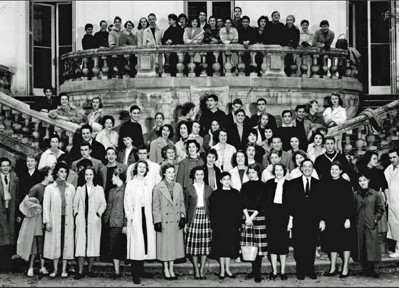
Class photo, Institut de Touraine, 1958 – 1959. Photograph retrieved from the JYF Alumni Magazine, 2016, p. 12.
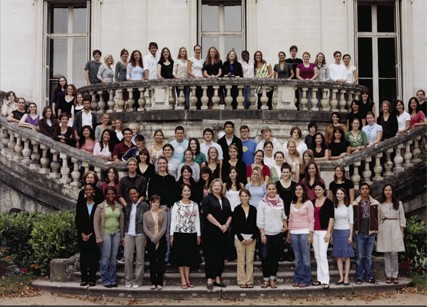
Class photo, Institut de Touraine, 2007– 2008 France, Sweet Briar 2007-2008, Photograph retrieved from the JYF Alumni Magazine, 2017, p. 15.
Sweet Briar established its administrative headquarters at Reid Hall, with the academic curriculum based in the French university system. Prior to the beginning of course, students benefited from a six-week intensive orientation at Reid Hall that helped them acclimate to the French language and to their new surroundings.
In 1949 – 1950, 73 students (53 women and 20 men) sailed on the SS Mauretania on September 8. They resided either at Reid Hall or with French families; the program preferred host-family housing for its students and mainly used Reid Hall as its administrative headquarters and tutoring site. Two scholarships were granted by the French government to JYF for that academic year. The students represented 21 states and 26 universities and colleges, mainly Vassar College (8), Bryn Mawr College (6), Sweet Briar College (5), and Mt. Holyoke College (5). Others came from: Baldwin-Wallace College, Barnard College, Bowdoin College, Cornell University, Dartmouth College, Fresno State College, Haverford College, Hollins University, Middlebury, Oberlin College, Scripps College, Skidmore College, Swarthmore College, University of Delaware, University of Maryland, Vanderbilt College, Washington University, Wheaton College, Whitman College, Wilson College, and Yale University. The director was Dr. Blanchard L. Rideout, assistant dean of the College of Arts and Sciences at Cornell University, assisted by Dr. Mary Lane Charles, professor of French at Western College, Oxford, Ohio.
Of the eleven different majors, there were 28 students in French, 7 in political science, 8 in art, and 4 in history. Of the 20 men in the program, 4 came through the G.I. Bill (New York Herald Tribune, June 16, 1949, n.p.). After their six-week intensive orientation (phonetics, grammar, composition, dictation, explication de texte, etc.), students followed courses at the Sorbonne, École du Louvre, and Sciences Po. Their tutorials were held at Reid Hall (Richmond Times Despatch, April 19, 1949). According to Anderssen:
The class of 1950, consisting largely of veterans of World War II, was in the opinion of many of us the best class ever, and the flexible program provided in the Cours de Civilisation Française, Faculté des Lettres, Institut de Phonétique, École du Louvre, Sciences Po, as well as Reid Hall, provided ample room for freedom of choice. The theater, museums, concerts, and the inexhaustible resources of Paris all added to the education and to the opportunities for self-education of this superior group of students (JYF Newsletter, 1977, 8).
According to Leet's 1950 – 1951 report, "On June 30, 1951, the Sweet Briar group withdrew to other quarters due to its policy of placing all of its students in French families." Since the agreement between Reid Hall and Sweet Briar stipulated that they could only hold classes and use common spaces at Reid Hall if they housed at least 10 of its students at the Hall, the program moved their headquarters to the building of the Carnegie Endowment for International Peace at 163 Bd. St. Germain. That year, 74 students were enrolled in the program and the six-week intensive was held in the city of Tours, returning to Paris for their classes at Sciences Po, the École du Louvre, and Faculté des Lettres. The director was Dr. Charles A. Choquette, of Colgate University, assisted by Dr. Annette Dobbin, of New York State College for Teachers at Albany.
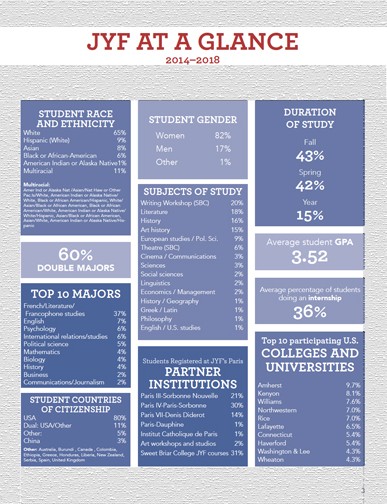
JYF AT A Glance, 2014 – 2018, JYF Alumni Magazine, 2016, p 3.
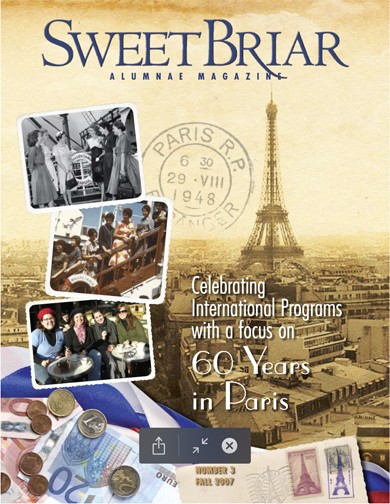
Cover of the JYA Alumni Magazine, Fall 2007, no. 3.
Through 2020, the program followed the 1957 – 1958 model with an orientation at the Institut de Touraine (Tours), followed by classes in Paris. Its reputation grew as did the student body, with over 100 students in residence in any given year. Details about the curriculum, activities, and stories on student and faculty experiences can be found in their Alumni Magazine and Alumni Newsletter. Over the years, the largest numbers of students came from Bryn Mawr College, Carleton College, Cornell University, Dartmouth College, Holyoke College, Princeton University, Radcliffe College, Sweet Briar College, and Yale University.
In a 1960 Wall Street Journal article on the large number of students studying abroad, psychologist Dr. Robert Pace of Syracuse University claimed that the impact of the program on the intellectual and social maturity of Sweet Briar students was significant, and that it also perfected their understanding of international affairs (Toy 1960).
The program moved its headquarters several times between the 1950s and early 1960s, beginning with the Bd. St. Germain, and then volleying between Reid Hall and the Alliance Française:
The JYF headquarters has moved to a new address in Paris. After ten years at Reid Hall, we are now located in quarters originally planned for the Junior Year in France some twelve years ago by Dr. R. John Matthew and M. Marc Blancpain, Secretary-General of the Alliance Française. Located on the seventh floor (French style) of the Georges Duhamel Annex of the Alliance Française, 34 rue de Fleurus, 75006 Paris, the locaux consist of administrative offices and secretariat, two classrooms, a seminar room, a reading room and a large terrace which we hope will help replace partially at least the garden at Reid Hall. It presents a delightful view of the chimney-pots of the Latin Quarter; the trees of the Luxembourg Garden, and the dome of the Pantheon are visible in the easterly direction and what some refer to as the "Awful Tower" (the 60 storey, Tour Maine-Montparnasse) is visible in the westerly direction. The new quarters face the apartment that Gertrude Stein lived in for so many years and of which Ernest Hemingway wrote in A Moveable Feast. Those students who remember the old Alliance Française quarters of the JYF in the 50s and early 60s will no doubt also recall the long climb to the fifth floor offices there. They will be pleased to know that we have a large ascenseur available now to the seventh floor (Alumni Newsletter, 1974, 17).
The JYF program returned to Reid Hall in 2016 and remained through Spring 2020, when the program was cancelled, despite its long and successful career. At that time, the Sweet Briar website announced a significant shift in priorities:
Sweet Briar’s junior year abroad program in France is among the oldest and most venerable of such programs in the country. Its endowment has largely supported students through scholarships. In recent years, the support has gone mostly to students from colleges other than Sweet Briar, as the number of Sweet Briar students interested in the French language and culture has dwindled.
Now in the midst of the COVID-19 pandemic that has led to suspension of study abroad programs in France and elsewhere, Sweet Briar College is embracing more effective ways, other than the traditional study abroad programs, to expose its students to the dynamism of a global cultural experience. "Global exposure for students has been shifting from spending an entire academic year or semester in a foreign country to more rapid immersion activities, global internships and study in Europe and elsewhere," said President Meredith Woo. "Sweet Briar College has two three-week terms built into its calendar that are uniquely suited for an immersive study abroad'"(https://sbc.edu/jyf/).
Sources
- "American Students arrive for a Year of Study in Paris." Herald Tribune, 1949, n.p. Retrieved from the RH archives, scrapbook.
- Barker, Joseph, E. “Five Years of the Junior Year in France.” The French Review, vol. 26, no. 6, May, 1953, pp. 446-450. American Association of Teachers of French. JSTOR.
- Brinton, George E. Letter to Leet, March 14, 1946. Family Papers, Reid Hall, 1939-1947, Box 94A.
- "50 Students Sail to Study in Paris." New York Times, Aug 29, 1948, p. 5. ProQuest Historical Newspapers.
- “57 Americans Coming Over to Study in Paris. New York Herald Tribune, n.d., 1949. n.p. Retrieved from RH archives, scrapbook.
- "Five Local Students Among 53 Leaving for Study In Paris." The Hartford Courant, Sep 6, 1949, p. 7. ProQuest Historical Newspapers.
- "Heads France Study Plan." New York Herald Tribune, March 28, 1948, p. A8. ProQuest Historical Newspapers.
- "Hewlett Girl Named for Study in Paris." Newsday, May 1, 1953, p. 70. ProQuest Historical Newspapers.
- “Holyoke Girl Given Junior Year in France.” New York Herald, June 16, 1949, n.p. Retrieved from the RH archives.
- “Junior Year in France.” Alumni Newsletter, no 2, November 1975. p. 17. Internet Archive.
- “Junior Year in France.” Alumni Newsletter, no 4, November 1976. p. 8. Internet Archive.
- “On France, Junior Year Plan.” Sweet Briar News, n.d., p. 3. Retrieved from the RH archives, scrapbook.
- Pace, C. Robert. "The junior year in France: A Evaluation of the University of Delaware-Sweet Briar College program.” Published for Sweet Briar College by Syracuse University Press, 1959. HathiTrust.
- "Paris to Honor 73 students of U.S.Colleges: Offer Vin d'Honneur Today at Hotel de Ville Today to Sweet Briar Group." New York Herald Tribune 195?. Retrieved from the RH archives, scrapbook.
- "68 American Students to Pass Year in Paris." New York Herald Tribune, June 6, 1948, p. A4. ProQuest Historical Newspapers.
- “Student Group List Doubles for Junior Year in France.” Richmond Times Despatch, April 19, 1949, n.p. Retrieved from RH archives, scrapbook.
- Summers, Eileen. "Study Abroad Opens Way to Good Citizenship." The Washington Post and Times Herald, May 30, 1954, p. S6. ProQuest Historical Newspapers.
- Sweet Briar Adopts Foreign Study Plan: Taking Over Delaware U. Year-in-France Course." New York Herald Tribune, January 18, 1948, p. 3. ProQuest Historical Newspapers.
- Sweet Briar Alumnae Magazine, fall 2007, vol. 78, no. 3. Archive.org.
- "Sweet Briar College, JYF in Paris." Alumni Magazine, no. 43, December 2016.
- "Sweet Briar College shifts the endowment of its study abroad program in France to support global programming." sbc.edu/jyf/ consulted October 2020.
- Sweet Briar Plans Study Group in Paris." New York Times, January 13, 1948, p. 23. ProQuest Historical Newspapers.
- "Sweet Briar to Acquire an International Aspect." The Washington Post, August 27, 1950, p. L2. ProQuest Historical Newspapers.
- Toy, Steward. Staff Reporter. "Exporting Students: U.S. Colleges Expand Programs for Study in Foreign Countries." Wall Street Journal, December 9, 1960, p. 1. ProQuest Historical Newspapers.
- "Trinity Sophomore to Study in Paris." The Hartford Courant, May 18, 1961, p. 29. ProQuest Historical Newspapers.
- "Va. College Sponsors Foreign Study Plan." The Washington Post, January 13, 1948, p. B13. ProQuest Historical Newspapers.
- “Year-in-France Study Groups Take Exams for Enrollment." New York Herald Tribune, Paris, September 8, 1948, n.p. Retrieved from the RH archives, scrapbook.
Maryland
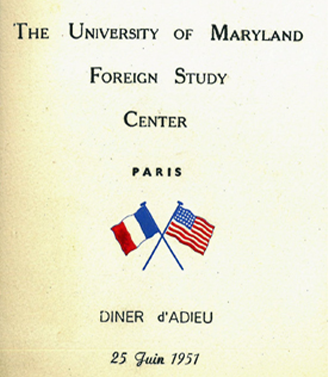
Invitation to goodbye party. Retrieved from RH archives, scrapbook.
The University of Maryland (UMD) inaugurated its program at Reid Hall in the spring of 1947, yet only remained for a few years. Their Paris Foreign Study Center is nevertheless worthy of note because it represented the first study abroad program for American graduate students. UMD also established a center in Zurich, and later one in Munich. Graduate students, mainly those specializing in language training, history, or political science, could earn the degree of Master of Foreign Study by passing several exams and presenting a thesis to the University of Maryland once they had completed their year abroad. While some students opted for a "certificate of foreign studies" (which only required regular course attendance), the majority earned the Master.
As with so many other programs abroad, the Master of Foreign Study was based on the premise that learning another language on-site would increase one's understanding of other cultures, especially when reinforced by courses in comparative literature, international relations, and world history.
Dieter Cunz, who headed the Zurich center in 1947 – 1948, published a summary of the programs' objectives and framework:
Any student who has completed his undergraduate work and has taken at least two years of the language spoken at the foreign university which he plans to attend may apply for admission to the Foreign Study Center through the Graduate School of the University of Maryland. The major fields offered at the present time are limited to languages, literature, history, geography, political science, psychology, and sociology. The Foreign Study office is attached to the Foreign Language Department and is headed by A. E. Zucker; the director of the program is Edmund E. Miller, who is in charge of the administration of the centers at Zurich and Paris (31).
According to Cunz, a professor from the Foreign Language Department was selected as resident dean who supervised the academic work of the students, assisted by one or two other professors from Maryland.
The first three weeks of the program served as an orientation period that introduced students to the country, city, and university where they had elected to study. Students also received intensive language training prior to attending local university courses. The UMD professors also attended the university classes so they could then deliver tutorials through which the students, whose language skills were initially wanting, could process the material covered in class. While these tutorials were not needed in the spring term, the UMD professors continued attending classes so they could generate coursework that met with UMD standards and requirements (tests and papers were not required in the European universities).
Students were also urged to make the most of their experience abroad by engaging in site visits and sociocultural activities on their own or organized for them:
[...] the purpose of the whole project would be defeated if the student should spend all his time behind books, and in lecture halls, libraries, and archives. The "living experience" in a foreign country should not be neglected – it is perhaps the greatest gain of his graduate year abroad. The student should have sufficient time for outside activities which – abroad more than at home – will widen his horizon (Cunz 34).
In Paris, the program began with 10 students and ended with 42; many were veterans whose education was financed through the G.I. Bill of Rights.
- 1947 – 1948: 10 students (resident dean: William F. Falls). Only one student was actually from the state of Maryland.
- 1948 – 1949: 33 students, five of whom were women (resident dean: William R. Quynn, together with his wife Dorothy MacKay Quynn). In his 1949 article, Hardie declares: "[...] 35 students, many of whom have never seen the Maryland campus or realized that their university has a football team, are taking part in a new and interesting experiment in American higher education. So far signs are favorable." UMD established its administrative headquarters at Reid Hall, in the “maison verte,” which had once housed a medical clinic. Hardie describes it as "[...] a small wooden building in a garden just off Boulevard Montparnasse.”
- 1949 – 1950: 42 students (resident dean: L. Clark Keating)
According to Dorothy Leet's report to the Reid Hall Board, the Paris Foreign Study program was cancelled in 1950 – 1951 because: "The University of Maryland is devoting its entire attention to a school for the Army, and has therefore been obliged to close its civilian courses temporarily" (RH Report 1950 – 1951, Barnard Archives). Leet was referring to UMD’s College of Members of the Armed Forces Overseas, which began in c. 1947. Described as "the University of the World," the College served 4,000 G.I.s in 52 European centers in 1951. By 1957, it was operating 200 centers in 19 countries. The program enabled many soldiers to complete their college work while serving in the US armed forces.
UMD never returned to Reid Hall, however, it established other study centers throughout Europe, including programs for undergraduates.
Sources
- Fowle, Farnsworth. Special ot the New York Times. "College Brought to G.I.'s in Europe: Higher Education Is Provided by the University of Maryland." New York Times, May 6, 1951, p. 20. ProQuest Historical Newspapers.
- Cunz, Dieter, "The Maryland Foreign-Study Centers." The Journal of Higher Education, January, 1950, vol. 21, no. 1, pp. 31-34 Published by: Taylor & Francis, Ltd. JSTOR.
- Hardie, Tom. "Maryland U. Has an Outpost in Paris." The Washington Post, July 24, 1949, p. L5. ProQuest Historical Newspapers.
- Harwood, William B., "'University Of The World' – Maryland Operates 200 Centers In 19 Countries." The Baltimore Sun, June 9, 1957, p. A1. ProQuest Historical Newspapers.
- Leet, Dorothy F. Annual Reports, 1948 – 1954. Barnard archives.
- Leet, Dorothy, F. Letter to Members, 1951 – 1964. Barnard archives.
- "Maryland Gives Courses For 4,000 G.I.'s Abroad." New York Times, May 27, 1951, p. 129. ProQuest Historical Newspapers.
- Ross, Albion. "6,500 G. I.'s Attend Overseas College" The New York Times, December 27, 1954, p. 19. ProQuest Historical Newspapers.
- "35 Students Going Abroad: Groups From U. of M. to Study German and French." The Baltimore Sun, Aug 11, 1947, p. 12. ProQuest Historical Newspapers.
- Toynbee, Arnold. "Maryland Abroad: Noble Experiment." The Washington Post, June 14, 1964, p. E6. ProQuest Historical Newspapers.
- Ward, Paul W. "Officials Differ Over U. Of M's. Profit By Foreign Study Plan." The Baltimore Sun, November 9, 1948, p. 32. ProQuest Historical Newspapers.
Middlebury
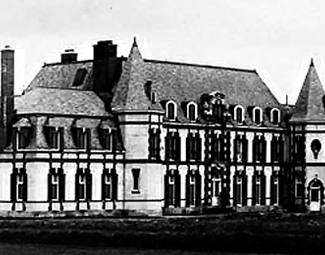
Middlebury chateaux. Photograph retrieved from
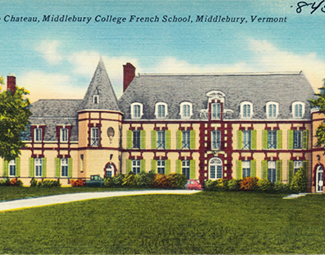
“Le Château,” inaugurated in 1925 as the first French House on an American campus. Over 40 Middlebury students who pledged to speak only French lived, ate and took classes there.
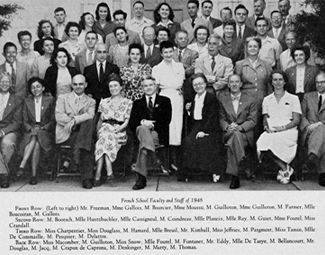
French school faculty and staff, 1948. Photograph retrieved from
For over fifty years Middlebury College’s School in France (1949-2003) played a major role in the life of Reid Hall.
Of the numerous American colleges and universities for which the study of foreign languages has been crucial to the academic curriculum, Middlebury College stands out as the most progressive and proactive. Drawing on colleagues from its own language departments as well as colleges and universities in the U.S. and abroad, the College founded the first advanced summer schools of modern languages in the United States, beginning with the German school in 1915, followed by the French School in 1916, and the Spanish School in 1917. These discrete programs aimed to educate graduate students and teachers not only in language instruction but also in cultural competence.
Beginning in the 1960’s, Middlebury also established undergraduate and then graduate programs in Italian, Russian, Chinese, Japanese, Arabic and Hebrew; undergraduate-level programs in Korean and Portuguese; and in 2020 a pilot program in Abenaki.
As early as 1923, the French School had also taken the lead in training students abroad. While the Middlebury programs in Vermont strove to immerse their students in the culture of the language they were studying by offering a comprehensive experience that included residing, dining, and socializing, they also encouraged a period of study in the foreign country itself. Living and studying abroad were deemed indispensable for any student attempting to acquire mastery of a foreign language or true knowledge of its society and culture.
Stephen A. Freeman, who began teaching French at Middlebury in 1925 and served as director of the Language Schools from 1946 to 1970, felt it was fundamental to the pedagogical objectives of their French program to go beyond recommendations and establish a formal plan to prepare American teachers for their careers by studying in France.
Armed with advice from Vincent Guilloton of Smith College, and from his own experience with the U.S. Army University in Biarritz (1945-1947), Freeman submitted a proposal to Middlebury’s Board of Trustees in October of 1948 for a year-long Master program in French in Paris:
“Briefly stated, the proposal was to select a limited group of graduate students planning to teach French, to prepare them by a preliminary summer of study at the French School in Middlebury, and to send them to Paris in early October. They would spend the academic year from October to June in a coordinated and approved program of advanced instruction on French linguistics, phonetics, literature, history, institutions and culture. These courses would be followed in various institutes or schools of the University of Paris. The students would work under the close personal supervision and guidance of a resident Director of Studies representing Middlebury College. At the end of the year, final examinations would be administered under his direction by the French professors. The successful candidates would receive the Middlebury College Master of Arts degree, in addition to any French certificats or diplômes they might have been able to earn (223-224).
Freeman’s plan met with approval: in November 1948, the Carnegie Corporation awarded Middlebury College $6000 to establish a Graduate School of French in France.
Prior to their studies in Paris, students would attend a preliminary summer of screening and preparation on campus at Middlebury.
In preparation for the opening of its Graduate School, Middlebury College secured two administrative offices at Reid Hall in 1949 and later increased its footprint there when space became available.
The model proposed in 1949 was followed for many years, with adjustments and adaptations based on student needs and the evolving French university system.
The Paris program required 30 points of credit comprising: an advanced course in written French, phonetics, literature, geography or history, and general culture courses. No two student programs were necessarily alike, since each individual devised a tailor-made curriculum of classes at the Institut de Phonétique, École de Preparation (later called the Institut des Professeurs de Français a l’Étranger), the Institut d’Études politiques, the École du Louvre, the arts and letters section of the Sorbonne, and the Institut Britannique. Students also signed a pledge to make French their language of “habitual communication” (Freeman 226).
A significant component was added to the program in the late 1950’s:
. . . in order to make the experience really worthwhile, we required each student to write a memoire or long paper, of some 30 pages, on a selected topic, under the guidance of the répétiteur. This paper, though not the equivalent of a Master’s thesis, had the added advantage of testing the student’s ability to write a serious piece of work in acceptable French, following the rules of French literary composition. It became an overall diagnosis of the student’s profit from the year of study (Freeman 233).
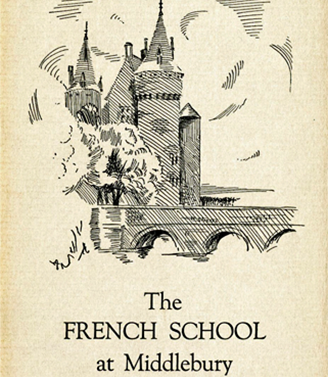
Front cover of the October 15, 1923 brochure published by Edward D. Collins, Director of the Middlebury Summer Schools. Courtesy Middlebury College.
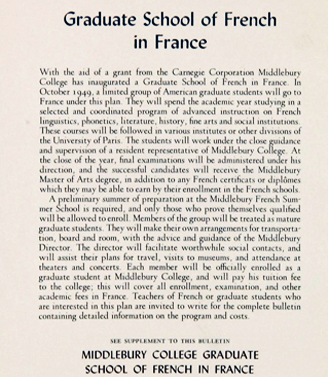
Brochure Graduate School of French
The Graduate School of French in France was a great success, attracting a large number of graduate students, some of whom eventually became professors at Middlebury. The directors were usually from Middlebury and other U.S.-based colleges and universities while French university professors were regularly invited to teach at Middlebury’s campus in the summer.
This brief overview of Middlebury at Reid Hall bears witness to the popularity of its programs.
In 1974, a program for juniors was developed alongside the graduate program, and as the program grew, agreements with several French institutions of higher learning were established, including: Paris X – Nanterre, Université Paris 1 Panthéon-Sorbonne, Université Sorbonne Nouvelle Paris 3, Université Paris Diderot- Paris 7, Institut d’Études Politiques de Paris (Sciences Po). Special arrangements were made for qualified undergraduate students to take courses at École Spéciale d'Architecture (ESA) (for Architecture majors only), École Normale de Musique de Paris Alfred Cortot (ENM) (for Music majors only), Schola Cantorum, École des Psychologues Praticiens (EPP) (for Psychology majors only), Institut Catholique de Paris, and École des Hautes Études en Sciences Sociales (EHESS).
The number of juniors participating in the program increased regularly, eventually outnumbering the graduates. Though many of the students majored in disciplines other than French, the core commitment to language and cultural immersion remained.
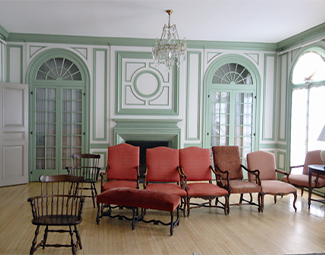
Salon of Middlebury's Château. Photograph retrieved from
The Middlebury program left Reid Hall in 2003 to set up headquarters near the place de la Madeleine. Excerpted below is the letter Michael R. Katz, Dean of Language Schools and Schools Abroad, sent the Director of Reid Hall, Danielle Haase-Dubosc, announcing the departure:
“. . .Middlebury has come to the realization that its location at Reid Hall no longer correspond to the goals for which the Middlebury students and faculty strive; that is total immersion in a French-speaking environment in order to achieve advanced fluency in the French language and a true understanding of French culture. It has become increasingly difficult to achieve this goal at Reid Hall. Furthermore, as tuition has risen in the U.S., Middlebury has found a growing discrepancy between student and faculty expectations of services and facilities, and those that Reid Hall has been able to provide.” (RH Archives).
From a single school begun at Reid Hall in 1949, Middlebury’s 38 C.V. Starr Schools Abroad now number 38, located in 17 countries across 5 continents.
Sources
*Enrollment figures vary according to the accounts; those identified here stem from Freeman’s book, which represents a very comprehensive and dense history of Middlebury’s foreign language Schools.
- Andres, Glenn M. “A Walking History of Middlebury,” designed and edited for the Web by Anne Callahan. http://midddigital.middlebury.edu/walking_history/college_campus/page_5.html
- Binzen, Peter, “Taking the Middlebury Pledge, » Change , Jan., 1978, vol. 10, no. 1, Report on Teaching: 5 (Jan., 1978), pp. 42-44 Published by: Taylor & Francis, Ltd. Stable URL: https://www.jstor.org/stable/40162848
- Freeman, Stephan A. The Middlebury College Foreign Language Schools, 1915-1979: The Story of a Unique Idea, Middlebury College Press, Middlebury, Vermont, 1975. https://archive.org/stream/mls_1915-1970/1024_djvu.txt
- “Graduate School of French.” Higher Education, volume 5, no. 14, March 15, 1949, p. 166.
- “Middlebury College Graduate School of French in France.” Higher Education, volume 6, no. 10, January 15, 1950, p. 119.
Yale
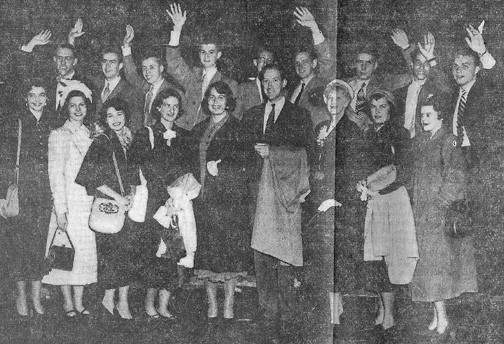
Yale Summer Study Students, waving goodbye from the boat Georgie, New York Herald Tribune, June 15, 1950, n.p.. Retrieved from the RH archives, scrapbook.
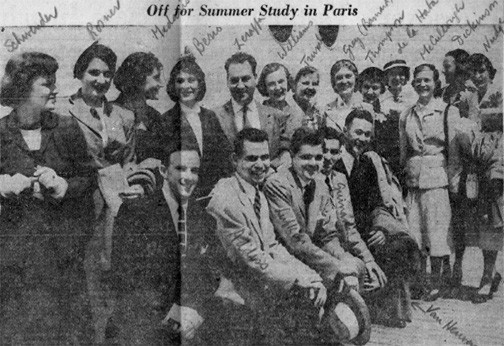
Yale Summer Study in Paris, 1951. Photograph retrieved from the New York Herald Tribune, June 13, 1951, p. 13. ProQuest Historical Newspapers.
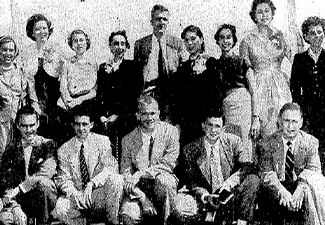
Yale Summer Students on the SS Waterman, 1952. New York Herald Tribune, June 11, 1952, p. 29. Photograph retrieved from ProQuest Historical Newspapers.
Launched in June 1950, this summer session was designed for students with two years of college French or its equivalent. In the first year, it attracted 28 students, 13 men and 15 women, from nine states and Puerto Rico. They sailed on the SS Georgic Cunard Liner and began their six-week summer studies by visiting Normandy and other sites in France. Led by Professor Theodore Andersson of Yale's French Department, they represented 13 American institutions, including: Yale University (7 students), Dartmouth College, Bowdoin College, Georgetown University, Columbia University, University of Michigan, Rochester College, Wellesley College, Barnard College, Bryn Mawr College, Mt. Holyoke College, and the New Jersey College for Women.
The same model would generally apply to the future iterations of the program, which would operate under the leadership of Andersson and Leet. The group typically arrived in Liverpool two weeks prior the start of classes, allowing them to tour England and France – Normandy and chateaux country. They then settled at Reid Hall and enrolled in classes at the University of Paris and the Louvre; mid-session, trips were organized to Fontainebleau, Bourges, Vezelay, and other sites (New York Herald Tribune, June 15, 1950, n.p.). They would also attend at least two plays in Paris.
1950: 28 students arrived from 13 different colleges, of which 15 were women and 13 men.
1951: 20 students arrived from 12 different college and universities, including: Yale University, Vassar College, Cornell University, Georgetown University, Wells College, George Washington University, Barnard College, New Jersey College for Women, Hood College, Pembroke College, Brown University, and Wellesley College – all sailing on the SS Washington liner. Their Director was Michael Zeraffa from French Department at Vassar College (New York Herald Tribune, June 13, 1951, RH archives).
According to the RH report that year, there were 36 students enrolled, men and women equally divided, from 15 colleges and 3 preparatory schools. They followed courses at the Institut d' Études politiques, the Sorbonne, and the École du Louvre. They also conducted site visits and attended plays at the Opéra Comique and the Comédie française, including Jean-Paul Sartre's "Le Diable et le bon Dieu." Reid Hall awarded the program three residence scholarships.
1952: 26 students arrived, including 6 from Yale and 20 from other colleges and universities: Barnard, College Brooklyn College, Cornell University, Georgetown University, Bryn-Mawr College, Vassar College, Wells College, the American University, Michigan University, Tennessee State University. The youngest in the group was 17 and a graduate of Phillips Academy, the oldest was 67 and a graduate of the American University(New York Herald Tribune, June 11, 1952, 29). Professor and Mrs. Armand Bègues directed student activities. In addition to co-curricular site-visits, students attended several plays, including "Tartuffe" at the Comédie française, "Le Cid" at the Théâtre national populaire at the Hôtel de Soubise, and a modern play, "Cuisine des Anges." Again, Reid Hall awarded the group two residence scholarships.
1953: 25 – 28 students arrived, with only 3 coming from Yale, the others from 21 different colleges, universities, and secondary schools: Wellesley College, Cornell University, Pembroke College, Indiana University, Smith College, Barnard College, Harvard College, Dartmouth College, George Washington University, University of Virginia, Wheaton College, and Wells College. Their director was Theodor Andersson, Associate Professor French at Yale. Michel Guggenheim, Institute of Language and Linguistics, Georgetown Foreign Service School was in charge of student activities (New York Herald Tribune, May 22, 1953, 19). This year saw the addition of immersive French training for teachers.
1954: 35 students and teachers arrived from different colleges, universities, and secondary-school students: Brearley School, Phillips Exeter Academy, Loomis School, Barnard College, University of Texas, University of Oklahoma, Purdue University, New Jersey College, Wellesley College, Gunnery School, Yale University, Smith College, University of Notre Dame, Cornell University, Georgetown University, Bradford Junior College, Beaver Country Day School, Connecticut College for Women, Mount Holyoke College, and Princeton University. Michel Guggenheim, Institute of Language and Linguistics, Georgetown Foreign Service School (New York Herald Tribune, June 12, 1954, 6) was in charge of the student activities. They attended plays at the Comédie française: Jean Anouilh's "L'Alouettte" and Molière's "Bourgeois Gentilhomme."
1955: 27 of the Yale summer students sailed together with 800 other students (including the Princeton University Jazz Band) bound for Europe on the Dutch ship SS Waterman. They were accompanied by a group of 24 educators and journalists who provided orientation on-board – organized by the Netherlands Office for Foreign Student Relations and the U.S. National Student Association. The schools represented were: Yale University, Wellesley College, Denison University, Wake Forest University, University of Michigan, Cornell University, Mt. Holyoke College, Youngstown College, University of Pennsylvania, Georgetown University, Barnard College, Smith College, Wheaton College, Goucher College, Bryn Mawr College, Syracuse University, Brearley School, Phillips Academy, Gunnery School, and the Boston School of Occupational Therapy. Their director was: Professor Linn Edsall, Wayne University (New York Herald Tribune, May 14, 1955, 24) and New York Herald Tribune, June 25, 1955, 5).
1956: 23 students arrived from different colleges and universities: Hood College, Bucknell College, University of Oregon, Brooklyn College, Dickinson College, Cornell University, Yale University, Simmons College, Catholic University of America, Vassar College, Wheaton College, Princeton University, Washington and Lee University, and Harvard University (New York Herald Tribune, June 22, 1956, 14). Their director was Professor James F. M. Stephenson, Jr., Assistant Professor of French, Yale University.
1957: 75 students arrived (according to the Bureau of University Travel) led by acting director Professor Neal Oxenhandler, a former student at the Sorbonne and instructor of French at Yale. The Yale-Reid Hall summer session had modernized its offerings and had become increasingly popular: students were given the option to travel to France by boat (for $800) or via airplane (for $1,000). The course offerings had also expanded to include French foreign politics, taught at the Institut d' Études Politiques, and French art and architecture from the Middle Ages to Impressionism at the École du Louvre. The program still included excursions to Normandy and the chateaux of the Loire in addition to weekend visits to Versailles, Fontainebleau, etc. (Yale-Reid Hall brochure). A teacher of French in the program remarked: "I think that there is no question that the Yale-Reid Hall group has the finest summer study program in Paris" (Leet letter to members, 1957).
1958: 9 students arrived from Stanford University, Smith College, Penn State University, Brooklyn College, Northwestern, Brearley School, and Hill House High School (New York Herald Tribune, April 30, 1958, 13).
1959: 33 students arrived (seventeen men, sixteen women), led by Professor Jean Boorsch, French Faculty at Yale University since 1934. According to the New York Herald Tribune, students from more than fifty U.S. colleges participated in the program since its inception (November 28, 1958, 15). The former French Fulbright scholars who had studied in the U.S. were invited to Reid Hall to take their meals with the Yale-summer group.
1960: The cohort was led by Professor Daniel Poirion, French Department, Yale University (New York Times, November 9, 1959, 136).
Sources (in chronological order):
- “Around the College Campuses.” New York Herald Tribune, February 19, 1950, p. A4. ProQuest Historical Newspapers.
- “Yale to Conduct Session in Paris.” The Washington Post, Feb 26, 1950, p. R10. ProQuest Historical Newspapers.
- “26 students sail for six weeks of study in Paris.” New York Herald Tribune, June 15, 1950, p. 16. ProQuest Historical Newspapers.
- “20 Students Sail For 6 Weeks of Study in Paris.” New York Herald Tribune, June 13, 1951, p. 13. ProQuest Historical Newspapers.
- “25 Enroll to Study at Reid Hall in Paris.” New York Herald Tribune, June 7, 1952, p. 12.
- ProQuest Historical Newspapers.
- “26 Students of Yale-Reid Hall Summer Session Sail for Paris” New York Herald Tribune, June 11, 1952, p. 29. ProQuest Historical Newspapers.
- “28 Off to Paris June 25 for Yale-Reid Hall Study.” New York Herald Tribune; May 22, 1953, p. 19. ProQuest Historical Newspapers.
- “Students Sail to Attend Paris' Yale-Reid School.” New York Herald Tribune, June 25, 1953, p. 21. ProQuest Historical Newspapers.
- “34 Students Off for Paris on Yale-Reid Hall Program.” New York Herald Tribune, June 12, 1954, p. 6. ProQuest Historical Newspapers.
- “Yale-Reid Hall Summer Session.” New York Herald Tribune, May 14, 1955, p. 5 ProQuest Historical Newspapers.
- “Yale-Reid Hall Students Among 800 Off to Europe.” New York Herald Tribune, June 25, 1955, p. 24. ProQuest Historical Newspapers.
- “23 Going to Paris for Yale-Reid Hall Session.” New York Herald Tribune, June 22, 1956, p. 14. ProQuest Historical Newspapers.
- “Yale Names Reid Hall Director.” New York Times, November 28, 1958, p. 35. ProQuest Historical Newspapers.
- “Named Director of Yale-Reid Hall Program in '59.” New York Herald Tribune, November 28, 1958, p. 15. ProQuest Historical Newspapers.
- “Yale-Reid Hall Director.” New York Times, November 1, 1959, p. 136. ProQuest Historical Newspapers.
- Yale-Reid Hall Summer Session in Paris, 1957. Brochure, retrieved from the Smith archives.
Third Year in Paris
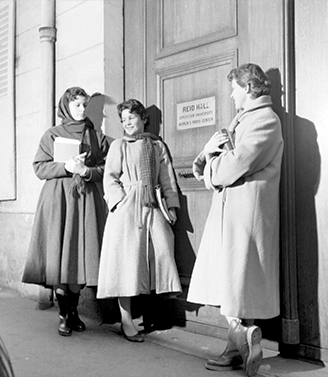
Students outside of Reid Hall, 1950s. Photograph retrieved from U.S. National Archives & DVIDs.
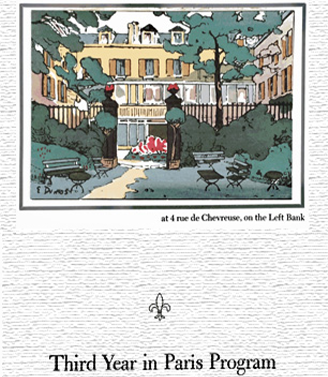
Cover of the Brochure of the Third Year in Paris Program. RH archives.
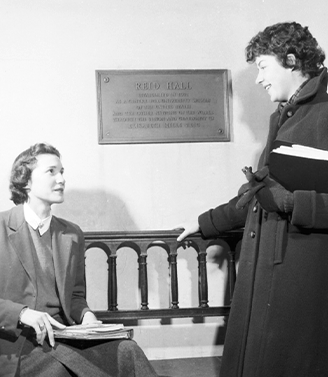
Students inside entrance to Reid Hall, 1950s. Photograph retrieved from U.S. National Archives & DVIDs.
Perhaps the most significant academic program of Reid Hall’s post-WWII era was the Third Year in Paris Program, conceived by Dorothy F. Leet, Reid Hall's director, and brought to life with the help of Virginia C. Gildersleeve. A meeting was held in New York at the home of Board member Mrs. Thomas S. Lamont to present the idea of this third year program to administrators and directors of American junior colleges for women. The minutes of the meeting of the advisory committee (November 25, 1952) included the program proposal.
In her report to the Reid Hall board, Leet summarized the objectives of this program:
[...] for a select group of students recommended by accredited Junior Colleges, who wish to spend an academic year in Paris gaining further knowledge of French civilization. It offers courses in art or music, political or social sciences, French language and literature, and includes a special course on the French theater (RH Report, 1952 – 1953, Barnard Archives).
The overall curriculum required a mix of courses both at Reid Hall and at French universities, as well as site visits and excursions.
Students enrolled in 30 – 32 semester hours of credit, 12 – 14 hours in French language and literature, 6 in the history of drama, 6 in art history, and 6 in French history. Although the courses and instructors would vary, the list below is representative (Bennet file, Smith Archives):
- “Cours d’orientation à L’École supérieure de préparation," Sorbonne, en octobre –15 hours weekly--required of everyone.
- “L’art français du Moyen Âge et de la Renaissance.” Three hours weekly taught by Madame Goldscheider, École du Louvre. And “L’art français des 19e et 20e siècles.” 3 hours weekly, Monsieur Sérullaz. Visits to Paris churches, Saint Denis, etc. Visits to Louvre or Orangerie.
- “Littérature des 19e et 20e siècles en France." Monsieur Van den Heuvel, Centre International Pédagogique, Sèvres.
- “Littérature du Moyen Âge et de la Renaissance en France," Miss Bennett, 3 hours weekly.
- “Le Théâtre en France,” Monsieur Georges Sallet, Agrégé des Lettres, Professeur au Lycée. 18 planned excursions to theaters.
Excursions usually took place early in September (Normandy, Burgundy, Châteaux of the Loire, Chartres, Mont St. Michel, Angers, Fontevrault, Azay-le-Rideau, Chenonceaux, Bourges, Vézelay, Fontainebleau, Versailles), with a weekend excursion to Belgium in October (beginning in 1959). Visits to museums, theaters, and other sites of interest in Paris complemented the coursework.
A 1952 alumna from Barnard College and recipient of a Fulbright Fellowship to study in Paris, best summarized her experiences in the program:
I had been staying at Reid Hall, the American University Women’s Center, and had come to love this Montparnasse quarter, with its quiet tree-lined avenues that suddenly come alive with neon and nightclubs after midnight, with its artists and quaint old studio buildings. It was a nice surprise, therefore, to find a room not far away, on the other side of the boulevard, in the same house with “Chez Henriette,” a good and inexpensive little restaurant well-known to many students [...] The courses are all interesting and should help in my preparation for teaching. My program includes phonetics, theoretical and practical grammar for teachers, translation, French history and two lit. courses – one medieval and one 19th century. All kinds of trips and activities are planned for us. I have visited an automobile factory (modern, a pleasant place to work, but allegedly seething with Communists), the Gobelins tapestry works, and the well-known École Normale Supérieure; André Siegfried, François Mauriac, Jean Vilar and many others have given interesting and unusual lectures; and we have made several group trips to such places as Chartres and Rouen. In the near future is a trip backstage at the Opera and a visit to the Assemblée Nationale (Barnard Alumnae Magazine, May 1953, 5).
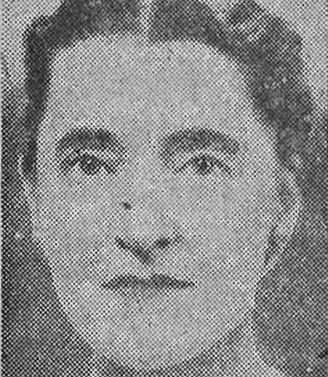
Barbara M. Clough, Director 1958 –1960. Photograph retrieved from the New York Herald Tribune, June 2, 1958, p. 7.
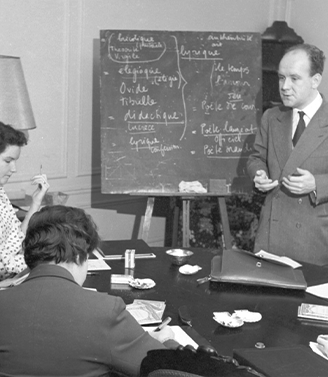
Students in class, 1950s. Photograph retrieved from U.S. National Archives & DVIDs.
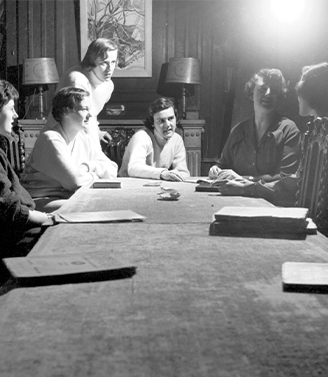
Students in Reid Hall's Library, 1950s. Photograph retrieved from U.S. National Archives & DVIDs.
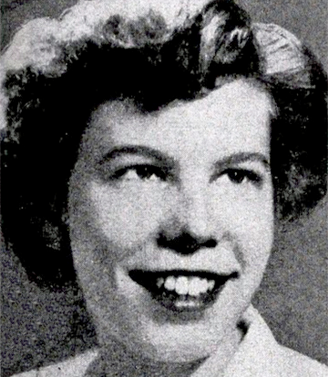
Elizabeth Blake, class of 1952, Barnard College. Photograph retrieved from Barnard Alumnae Magazine, May 1953, p.5
The program came to en end in 1964 when Reid Hall was gifted to Columbia University by Helen Rogers Reid. Over the course of its ten-year existence, the program attracted an average of 25 students. By 1964, the cost of the program, including housing, ranged from $2,250 – $2,750.
1952 – 1953: 8 students arrived from Barnard College, Leland College, Stanford University, Swarthmore College, and the University of Kansas. They began their semester with an orientation period involving excursions to the Chateaux de la Loire, the Mont St Michel, Bourges, and Vezelay. In November, they enrolled French civilization and language courses at the Sorbonne, art and art history at the École du Louvre, and theater – with attendance at eighteen theater productions.
1953 – 1954: 21 students arrived from Bradford (8) and Pine Manor Colleges in Massachusetts, Briarcliff College, St. Lawrence University in New York, Mt. Vernon and Margaret Webster Colleges in Washington D.C., Christian College in Missouri, the Winsor school in Boston, and the Sidwell Friends Seminary in Washington.
1954 – 1955: Together with their director, students sailed on the SS United States after enjoying tea at the Westbury Hotel in New York. In the fall, the program added a course for beginners in French so they could enroll in regular coursework in the spring. The students originated from Bradford College, Lasell and Fine Manor in Massachusetts; Hollins College in Virginia; University of Wisconsin; University of Michigan; Rockford College in Illinois; Western College in Ohio; Finch College; the lycée at Kabat; Winsor school in Boston, Brearley school, and Miss Finn's school.
1955 – 1956: 24 students from colleges and accredited junior colleges, including four from Mexico, sailed together with their director, after enjoying tea at the Westbury Hotel in New York City.
1956 – 1957: 24 students arrived from eight colleges, including four from Mexico.
1957 – 1958: Together with their director, students attended a tea for 50 guests at the Westbury hotel before sailing on the SS United States.
1958 – 1959: no numbers indicated.
1959 – 1960: 20 students arrived from 16 colleges and schools. They spent the full year studying French language, literature, medieval studies, theatre, and the history of French art. A weekend trip to Belgium was included. The Winsor school of Boston provided scholarship to the top French student for the Third-year program: "Winsor scholars are able to start college as sophomores in recognition of the academic excellence of the Reid Hall Third Year course, and graduate in three years" (Leet, minutes of annual meeting, January 14, 1959).
1960 – 1961: 28 students arrived from 14 colleges. A course on French History from 1660 –1960 was added to the curriculum.
1961 – 1962: 25 students arrived from 15 different colleges and universities.
1962 – 1963: 25 students arrived from 15 different colleges and universities.
Sample Memorandum prepared by the director Charlotte Girard sent to students in the 1962 – 1963 program:
In general the clothes you wear for college at home will be correct. Sweaters and skirts are right for class. Slacks and shorts are not worn in the garden or public rooms of Reid Hall, in class, nor on the street, and are not often appropriate in Europe. Suits are good, some simple wool dresses, a few dresses for afternoon and evening (short). Bring a warm coat, a raincoat, perhaps a storm coat for winter. Paris is damp in the winter and light weight woolens are welcome. In addition to a light negligee you will need a warm one and warm slippers. You will be glad to have bedjackets. Pack ski clothes if you plan to ski during the Christmas vacation. Be sure to bring enough comfortable shoes. You will walk miles. A few summer clothes will be useful in May and June. In general plan carefully for storage space is limited. Bring nylon underwear and nylons. Kleenex, Kotex or Tampax are available but expensive in France. Bring a hot water bag. You will need an English dictionary, as well as an English-French one, and a handbook on mythology. A good supply of small photographs of yourself is necessary. An allowance of fifty dollars a month should be adequate for normal personal expenses. Money may be brought in traveller’s checks; or personal checks on American banks, endorsed by the President of Reid Hall, may be cashed at the bank used by Reid Hall. It is customary in France for the students to give four dollars per student to the Christmas Fund for the personnel, and ten dollars at the end of the year in June for the personnel.
1963 – 1964: 28 students arrived from 13 different colleges and universities.
The program was led by a series of different professors:
1953 – 1954; 1954 – 1955; 1955 – 1956; 1956 – 1957; 1957 – 1958: Miss Alice Ross Bennet, returned to the U.S. Her letter of resignation was dated June 3, 1958.
1958 – 1959, 1959 – 1960: Barbara M. Clough, studied in Lausanne, Paris, and the University of New Hampshire. Former Headmistress of the Northfield School for Girls, she was Dean at the George School in Northfield, President of the Association "American Friends of the Collège des Cévenol," and a member of the board of trustees of Colby College in New Hampshire.
1960 – 1961: Dorothea Norwood, French Department, Bradford Junior College.
1961 – 1962: Catherine Fehrer had received her PhD from Bryn Mawr and was professor of French language and literature at Suffolk University. She also had studied at the Sorbonne and the École normale de Sèvres and had served as Assistant Director of the Sweet Briar Program in Paris.
1962 – 1963, 1963 – 1964: Charlotte Girard, former head of French House at Bryn Mawr, she grew up in France but studied at the University of British Columbia. She also had taught at the University of Vancouver.
Sources
- "Barnard Alumnae Abroad: Two Fulbright Scholars Write Home." Barnard Alumnae Magazine, May, 1953, pp. 5-6. Barnard digital archives.
- Fehrer, Catherine. Memorandum to students in the 1961 – 1962 Program. RH archives.
- Girard, Charlotte. “Things to do – Third Year in Paris, 1963 – 1964. RH archives.
- Leet, Dorothy F. Annual Reports, 1948 – 1954. Barnard archives.
- Leet, Dorothy, F. Letter to Members, 1951 – 1964. Barnard archives.
- "New Reid Hall Director Named." New York Herald Tribune, June 2, 1958, p. 7. ProQuest Historical Newspapers.
- "Paris Study Director: Miss B. M. Clough to Head Reid Hall Third-Year Plan" New York Times, June 2, 1958, n.p. Retrieved from RH archives, scrapbook.
- “Reid Hall Tea for Fifty Today.” New York Herald Tribune, September 18, 1957, p. 17. ProQuest Historical Newspapers.
- Third Year in Paris Program – Reid Hall. Brochure. RH archives.
Hamilton
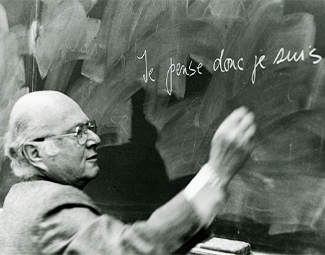
Marcel Moraud, Hamilton College. Photograph retrieved from Hamilton.edu
Hamilton College in the state of New York set up headquarters for its "Junior Year Group" at Reid Hall in 1957, using the garden building for their staff and classroom. Both men and women were admitted to their program. A total of 32 students were enrolled, stemming from 18 different colleges and universities, including Hamilton but also Williams College (Massachusetts), Bowdoin College, Colby College, and Bates College in Maine. The students, who each paid $2,200 in tuition fees for the year, were accompanied by two faculty members. In 1958 –1959, they had approximately 45 students.
Marcel Ian Moraud, head of the French department, is the one who founded Hamilton's Junior Year in France and was its first administrator. James Davis, professor of French, only had words of praise for the teacher and administrator:
Marcel Moraud was chairman of the Department of Romance Languages and Literature from 1950 to 1981 and set up the Junior Year in France program more than 25 years ago. His business acumen, common sense and wit always added a lively extra dimension to any professional or social gathering. We will remember Marcel as a bon vivant, enjoying what life had to offer and especially appreciative of his relationships with family, friends and colleagues. Marcel’s sudden death on June 11, 1982, took from us a very generous man whose jovial and kindly presence as administrator and teacher will be missed by all who knew him (hamilton.edu/about/history/memorial-minutes/marcel-moraud)
In memory of Professor Moraud, family and friends established The Marcel Moraud Memorial Prize Scholarship. It is awarded to a French major who has returned from the Junior Year in France Program and "demonstrates academic excellence, strength of character and a sense of humor" (Hamilton.edu, financial aid and scholarships).
In 1963, James Davis, led the Hamilton College Junior Year [in France], returning eight times as head of the group: "[...] so much were his colleagues in admiration of his meticulous organizational skills that they asked Jim to prepare a directorial handbook. With regular updatings, that sacred text has been the major guide for every administrator since (hamilton.edu/about/history/memorial-minutes/james-b-davis). The James B. Davis Travel Grant, established in his honor, covers round-trip travel between New York – Biarritz – Paris –New York.

Vintage poster for the town of Biarritz. Retrieved from
Beginning in 1957, the students spend several days in Biarritz before beginning their studies in Paris. This tradition was initiated by Marcel Moraud, who was inspired by the 1945 adventure of the American university campus of Biarritz. The purpose of this stay is to acclimate the students to French life and culture, and to prepare them for our university and educational system. Students are housed with families, receive lessons but also engage in sports activities and excursions. In the past, they resided in Biarritz for a full month, but for economic and practical reasons, they gradually shortened their sojourn.
Two students who attended the program in 2004 describe how impactful the experience was for them:
During the first month of our year in France, we the students of the Hamilton group explored the small town of Biarritz and we lived there like real French people. The transition was a bit difficult for everyone (what a jet lag!) But after a week we were comfortable in our new French life. We took conversation, civilization, grammar, and a text study course. Our teachers (who are really great!) Have understood that it is difficult to be Americans in France. We made several excursions to other towns: we visited St. Jean de Luz, another small town near the beach; Bayonne, an old Roman town; Bilbao in Spain where we visited the Guggenheim Museum, and finally the magnificent cities of Toulouse and Carcassonne. [...] Tonight, we're going to celebrate the end of our stay in Biarritz with a farewell party! We are all impatient for our departure to Paris, but Biarritz will be sorely missed. Christophe Fazio et Sarah Prusasky, 24 septembre 2004
Besides Marcel Moraud, who regularly headed the program until his untimely death in 1982 (1957 – 1958, 1961 – 1962, 1966 – 1967, 1970 – 1971, 1974 – 1975, 1978 – 1979), other professors, usually from Hamilton's department of French and Francophone Studies, took turns as resident directors. They ensured oversight of the academic curriculum together with the Programs Abroad Committee in consultation with the Academic Council of Hamilton College:
- Reuben C. Cholakian, 1989 – 1990, 1985 – 1986, 1981 – 1982, 1977 – 1978, 1973 – 1974, 1969 – 1970, 1965 – 1966; Professor of French, Hamilton College (1957 – 1996).
- Alexander E. Dauge-Roth, 2019 – 2020, French and Francophone Studies, Bates College.
- James B. Davis, 1988 – 1989, 1984 – 1985, 1980 – 1981, 1976 – 1977, 1972 – 1973, 1968 – 1969, 1964 – 1965, 1963 – 1964; Professor of French, Hamilton College (1958 – 1991).
- Martine Guyot-Bender, 2021 – 2022, 2018 – 1919, 2014 – 2015, 2011 – 2012, 2007 – 2008, 2006 – 2007, 2001– 2002, 1997 – 1998, 1992 – 1993, Professor of French, Hamilton College; Licence Université de Metz; A.M. and Ph.D., University of Oregon.
- Franklin G. Hamlin, 1979 – 1980, 1975 – 1976, 1971 – 1972, 1967 – 1968, 1962 – 1963, 1958 – 1959; Professor of French, Hamilton College (1949 – 1980).
- Roberta L. Krueger, 2017 – 2018, 2013 – 2014, 2010 – 2011, 2005– 2006, 2004 – 2005, 2000 – 2001, 1996 – 1997, 1991 – 1992, 1987 – 1988, 1983 – 1984; Professor of French, Hamilton College; A.B., Wesleyan University; A.M. and Ph.D., University of California, Santa Cruz.
- Cheryl A. Morgan, 2016 –2017, 2012 –2013, 2009 –2010, 2002 – 2003, 1998 – 1999, 1993 – 1994, Professor of French, Hamilton College; A.B., Dartmouth College; M.A. Middlebury College; Ph.D., Columbia University.
- Joseph E. Mwantuali, 2015 – 2016, 2008 – 2009; Professor of French, Hamilton College; B.A. and M.A., University of Zaire; M.S., Southern New Hampshire University; Ph.D., Pennsylvania State University.
- John C. O'Neal, 2003 – 2004, 1999 – 2000, 1995 – 1996, 1994 – 1995, 1990 – 1991, 1986 – 1987; Professor of French, Hamilton College; A.B., Washington and Lee University; A.M., Middlebury College; Ph.D., University of California, Los Angeles.
The program halted its activities in 2020 – 2021 due the Covid 19 pandemic.
In 1995, John O'Neal and Roberta Krueger wrote articles on their experiences directing a study abroad program, respectively, "It's Like Wearing All the Hats" and "It's Not a Sabbatical." Their words ring true even 25 years later.
Sources
- sudouest.fr/2010/09/09/hamilton-college-en-decouverte-179902-4037.php
- hamilton.edu/academics/offcampusstudy/france/application-and-enrollment/financial-aid-and-scholarships
- marcel-travelposters.com/en/poster-biarritz-bains-de-mer.html
- Leet, Dorothy F. Reports to Reid Hall board and members, 1947-1963, Barnard and RH Archives.
- O'Neal, John and Roberta L. Krueger. "Directing a Program Abroad." Academe, September - October, 1995, vol. 81, no. 5, pp. 28-34 .Published by: American Association of University Professors Stable URL: http://www.jstor.com/stable/40250874
Other Programs
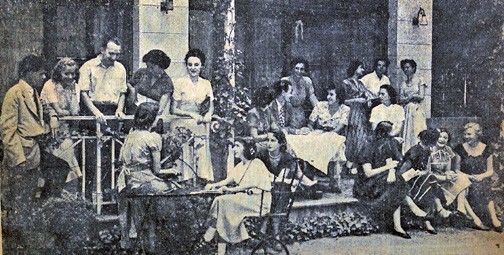
Bryn Mawr Study Group, Summer 1949, gathered on the veranda in front of Reid Hall's dining room; Germaine Brée is standing behind the table in the middle of the group. Photograph retrieved from the New York Herald Tribune, July 14, 1949, n.p. RH archives, scrapbook.
The Paris Study Group
- 1947 – 1948: 14 students were in residence, mainly from Catholic Colleges in the U.S.
American Relief Work in France
- 1947 – 1948: 16 graduate students were in residence, as well as their directors.
Bryn Mawr Summer Study Group, 1949
The group was headed by Germaine Brée, professor at Bryn Mawr College who would later introduce generations of American students and scholars to the works of Marcel Proust, Andre Gide, Albert Camus, and Jean-Paul Sartre. She was awarded the Knight's cross in the French Legion of Honor for her war service during WWII, when she befriended Albert Camus.
She oversaw the work of the 23 students (20 women and 3 men) who came to Reid Hall and attended a six-week intensive program that included courses on contemporary literature and language at the Sorbonne, art history at the Louvre (with site visits), and contemporary French international policy at the Institut d'études politiques. Students paid $725 for the program, which included: round-trip boat fare; a 10-day trip to Rouen, Caen, the invasion beaches, St. Lô, Mont St Michel, Fougères, Angers, Fontevrault, the Chateaux of the Loire, Orléans, and Chartres; all their courses; with additional trips to Vézelay, Bourges, and Fontainebleau; and two theater outings.
Two of the Reid Hall summer scholarships were assigned to students and one to the scholar in charge of the program.
UCLA Summer Session
The program was organized by assistant professor of French Oreste Pucciani. A firm believer of total immersion in a foreign language, he was known for his revolutionary teaching methods, which banned all English from his classroom. From 1946 – 1947, Pucciani studied in Italy and France, where he met Simone de Beauvoir and Jean-Paul Sartre, the latter of whose philosophy he taught at UCLA. Chair of the French department from 1961 – 1966, he taught at UCLA for 31 years. He was awarded the Knight's Cross of the French Legion of Honor in 1965.
Pucciani came to Paris, and Reid Hall, with his group of students from 1949 through 1951.
- 1949: Beginning of the summer session.
- 1950: Program's number of students increased.
- 1951: The program had an ever-increasing number of students and was awarded one residence scholarship by Reid Hall.
- 1952: The program was discontinued "due to decisions taken in California in regard to the State funds abroad" (Leet, RH report for 1952 – 1953).
University of Houston (Texas), summer program
- 1951: held a three-week session, with some of the 54 students housed at Reid Hall and others in a nearby hostel, all eating their their meals at Reid Hall.
- 1952: number of students not identified.
- 1953: number of students not identified.
- 1954: 54 students attended the summer session.
- 1955: 2-week summer course for men and women.
Bureau of University Travel, summer program
- 1957: 75 women and men came to Reid Hall with their professors.
- 1959: number of students not indicated.
Wooster College, Ohio, summer program
- 1954: 10 students.
- 1956: a small group in July.
- 1959: number of students not indicated.
American College Council for Summer Study
- 1953: 8 students of political science.
- 1954: number of students not indicated.
- 1955: 14 students, mostly from the University of Chicago (July and August).
- 1956: 65 students for a one-week intensive.
- 1957: seems to have stopped sending students.
Sophie Newcomb College from Tulane University
- 1955 – 1956
Moore Art School of Philadelphia
- 1955 – 1956
Sources
Information on these programs is mainly drawn from Dorothy Leet's annual Reid Hall reports (1948 – 1954) and her letter to members (1951 – 1964), Barnard College archives. See also:
- “Bryn Mawr Summer Study Group Assembles at Reid Hall.” New York Herald Tribune, July 14, 1949, n.p. Retrieved from RH archives, scrapbook.
- “Germaine Bree, 93, a Scholar of Modern French Literature.” New York Times, September 26, 2001, p. C15. ProQuest Historical Newspapers.